Rennie Scaysbrook | December 9, 2016
We team up with Kawasaki USA and Jason’s Pridmore’s Star Motorcycle School to try and unlock some hidden speed in Rennie’s arsenal.
 Late afternoon on day one at Chuckwalla as Rennie and the Kawasaki get to know each other.
Late afternoon on day one at Chuckwalla as Rennie and the Kawasaki get to know each other.
Racing a motorcycle is one of life’s great pleasures. It’s the only time I can think of when my mind is absolutely clear of any thoughts other than the task at hand—about passing the guy in front, or bettering a lap time, or trying to keep the guy behind me to the checkered flag.
Racing requires precision. A lot of this you can learn on your own, and you probably started subconsciously figuring out when you began walking as a toddler, like spatial awareness and perception to velocity and danger. A good set of these basic human skills should enable most humans to climb onto a motorcycle and ride it, but a couple of months ago, I thought I’d like to sharpen my own personal precision skillset much further. Therefore, I hatched a plan with Kawasaki USA to ride their Project Superstock ZX-10R racer in a couple of rounds of the Chuckwalla Valley Motorcycle Association’s Winter Series, as well as attend the renowned Jason Pridmore Star Motorcycle School in between races to try and coax out some extra precision, and therefore, speed.
To read this in Cycle News Digital Edition, click HERE
Photography by RS and Cali Photography
I’ve been riding motorcycles since I was 3 and racing since 8, although the last couple of years have been pretty sporadic on the racing front. I’ve done some WERA stuff this year and the Pikes Peak International Hill Climb, but most of my track riding has been machine testing of late. Track testing motorcycles for Cycle News is one thing—the idea to testing is you take the motorcycle to a consistent and relatively quick pace that’s repeatable, and then you can write an objective review of the machine—but racing at the sharp end of even a club Superbike race requires more speed, more bravery and yes, more precision, if you want to win.
 The first race weekend was pretty hectic, but Rennie walked away with a win nonetheless.
The first race weekend was pretty hectic, but Rennie walked away with a win nonetheless.
The Baseline
The idea for this story is to set a baseline time at round one of CVMA, then come to the school, get faster, and beat it for round two. My first time back on a superbike after six months off was a bit of an eye opener, to say the least. I was circulating about 10 seconds off the pace during first practice and wondering what the hell I was doing out there.
The ZX-10R had been set-up by Jason Pridmore, basically giving me a setting that enabled for a pretty neutral chassis, one that would just let me concentrate on riding rather than having to play around with suspension clickers too much.
Josh Hayes said to me last year that I spend too much time on the side of the tire, which makes it hard to get on the gas properly for the exit. Ever since then I’d made a concerted effort to stay more on the seat and not hang off as much, trying like hell to use as much of the middle part of the tire as possible in order to get maximum drive. The tactic appears to work (kind of) because the times start dropping substantially and I end up winning my last race on Sunday against a bunch of CVMA regulars. Not bad for being 10 seconds a lap off the pace on day one!
 Charge! The race to turn one is on!
Charge! The race to turn one is on!
The extra speed that comes on Sunday coincides with a bike that’s behaving far better than it was on Saturday, and this is purely down to riding it fast enough to make it work. Jason Pridmore had made a bike that was easy to ride at his pace, but until I got within four to five seconds of his lap time, I felt like the thing wanted to throw me off at the first opportunity.
Getting faster made the bike settle down, but even though I got into the 1:50s (the lap record is a 1:46.2 held by MotoAmerica rider, David Anthony), I couldn’t do it comfortably. The three areas I needed to work on were turning in too early, reducing the time between on/off throttle and getting my body in the right position to stand the bike up off the corner more on the exit. The turning in too early part was one that’s plagued me for years. Diving for the apex early is something I wish to high hell I could stop doing, and for me, would be the big thing to work on at Jason’s school.
For a full run down on how the first weekend at Chuckwalla went, including videos from both days, click HERE.
 Jason Pridmore lays down the lay at the school. His and his instructor’s input made a massive difference to Rennie’s riding.
Jason Pridmore lays down the lay at the school. His and his instructor’s input made a massive difference to Rennie’s riding.
Off To School
Jason Pridmore has worked with some of the best in the business. He’s a two-time Endurance World Champion, a discipline that requires steel-like concentration and focus to crank out lap after lap after lap in the dead of night within one second of your daylight lap time, and he’s also a two-time AMA Pro Road Racing Champion. He knows what he’s talking about.
You can’t be precious at a motorcycle school. You’re there to be critiqued, and if you swallow your ego you’ll come away a much better rider than when you started. One tip I will give fellow students before they go to a Star School (or any riding school, for that matter), is to know what you want to fix. For me, it was diving for the apex too early, getting my body position right for corner exit and reducing the on/off throttle time.
 Akrapovic titanium and carbon exhaust is a work of art. Dunlop’s super sticky soft-compound rubber kept things the right way up.
Akrapovic titanium and carbon exhaust is a work of art. Dunlop’s super sticky soft-compound rubber kept things the right way up.
The latter two points came with fixing the first point. Jason discovered I was diving to the apex because I wasn’t carrying enough roll speed, basically, not trusting the front tire enough. I was braking at about the right point of the corner, but I was braking too hard and slowing down too much.
When you slow down, the revs drop, and you naturally “fall” into the corner. With higher roll speed, the revs stay up, and you naturally want to stay wider in the corner, keeping up the corner speed and making yourself faster on the exit. Riding this way also stops the chassis from see-sawing. It keeps the bike more neutral and thus easier to ride.
 Jason speaks, the class listens. Pridmore has helped everyone from beginners to MotoGP riders to find that extra speed.
Jason speaks, the class listens. Pridmore has helped everyone from beginners to MotoGP riders to find that extra speed.
Getting the throttle opened a touch earlier helps keep the bike settled. Jason admitted to me he probably opens the throttle at 15 percent on the side of the tire, whereas I’d be opening it 20 percent, but a touch later than Jason. That extra five percent would put too many stresses through the chassis, and I’d run wide, ruining my drive.
This is something I will be working on for years. Cameron Beaubier is brilliant at this technique, and one that makes him so glass smooth on the bike. I haven’t nailed it properly yet, but I’ll keep working on it.
The final point of standing the bike up off the exit is a classic superbike technique that’s harder to master than you might think. In round one I’d be sitting too much in the center of the seat, not giving myself enough room you move on the bike. But I don’t want to get too far off, because then I’d be right on the side of the tire and unable to get all the grunt to the ground.
 Kawasaki’s Race Kit ECU. A weekend tuner’s playground.
Kawasaki’s Race Kit ECU. A weekend tuner’s playground.
It’s just a simple shift of the ass, but doing so changes everything—your upper body has to move in unison with you lower half, you can’t dip your shoulders into the turn, and you need to move the bike away from you (pick it up) as you power out hard on the exit. I think I only really nailed this on one corner, and could feel the bike instantly hook up, but like the on-off throttle, getting this technique consistently right will take more time than just two days at the school.
Regardless, the two days at Jason’s Star School did wonders for my riding and I’d recommend the school to anyone who wants to get faster.
For a full rundown on the two days at Jason Pridmore’s Star Motorcycle School, including videos from both days, click HERE.
 Vortex rearsets had to be chopped down to avoid grounding out in cornering.
Vortex rearsets had to be chopped down to avoid grounding out in cornering.
Crunch Time
The return weekend at Chuckwalla for round two of CVMA was crunch time for this project. Should I actually go slower than when I started, I’d have not just myself but also my boss, Kawasaki and Jason to answer to and, to be honest, that didn’t sound like a whole lot of fun.
I didn’t put myself in the best position to better my round-one performance, either. The previous two weeks I’d been home in Australia, drinking beer and hanging with mates in what is exactly the opposite of good preparation. And I only landed back in the U.S. on Wednesday afternoon, so by Friday I was super jetlagged and wanting to crawl up into a little ball in the back of the race truck.
 GP Suspension fettled Penske 8987 shock did its job over the project, although the team did change to a slightly heavier spring on the final day.
GP Suspension fettled Penske 8987 shock did its job over the project, although the team did change to a slightly heavier spring on the final day.
Friday was beset by electrical gremlins on our ZX-10R, anyway, so I need not have worried too much. I got a few laps in on Friday afternoon to make sure things were running smoothly and, for Saturday morning qualifying, stuck some sticky soft-compound Dunlop N-Tecs on to see if all those hours of training had made any difference.
They did.
 GP Suspension provided their own 25mm fork cartridge kit for the project. Rennie and Joey swapped out the electronic steering damper for a conventional Öhlins unit seen here.
GP Suspension provided their own 25mm fork cartridge kit for the project. Rennie and Joey swapped out the electronic steering damper for a conventional Öhlins unit seen here.
Immediately I went a 1:51, then a ’50, then ’49, then a 1:48.8. My goal was to get into the ’49s but to do a ’48; I was absolutely stoked. The best thing was the time came by focusing on the points Jason had already hammered in—the main one was carrying more roll speed.
I’ll admit I got a helping hand initially by Andrew Lee, the 17-year-old hotshot on an R6 that wiped everyone, including all the superbikes, over the weekend. Trying to chase after him, I braked where Jason wanted me to, carried more roll speed, and picked up at least a couple of tenths of a second per corner. I could feel I was going faster and, I was going faster more safely. That was a truly great feeling.
 By the time Rennie went back to Chuckwalla, he was averaging about 2.5 seconds per lap faster using Jason’s techniques.
By the time Rennie went back to Chuckwalla, he was averaging about 2.5 seconds per lap faster using Jason’s techniques.
My results for the round were 4-DNF-3-2-3, and had I not DNF’d in race two it would have been another podium in third. There were a couple of extra fast guys there that weekend that I simply couldn’t beat, but for me, that was beside the point of this endeavor. The race results themselves didn’t matter as such; it was more consistency in faster lap times. On average, my lap times dropped about two seconds from round one to round two, meaning the objective was met and the project was a success.
Now all I have to do is find a stash of money so I can finish off the rest of the year! CN
 More speed, accessed safer. Rennie on his way to a 1:48.8s lap.
More speed, accessed safer. Rennie on his way to a 1:48.8s lap.
For a full rundown on the final Chuckwalla race weekend including a video, click HERE.
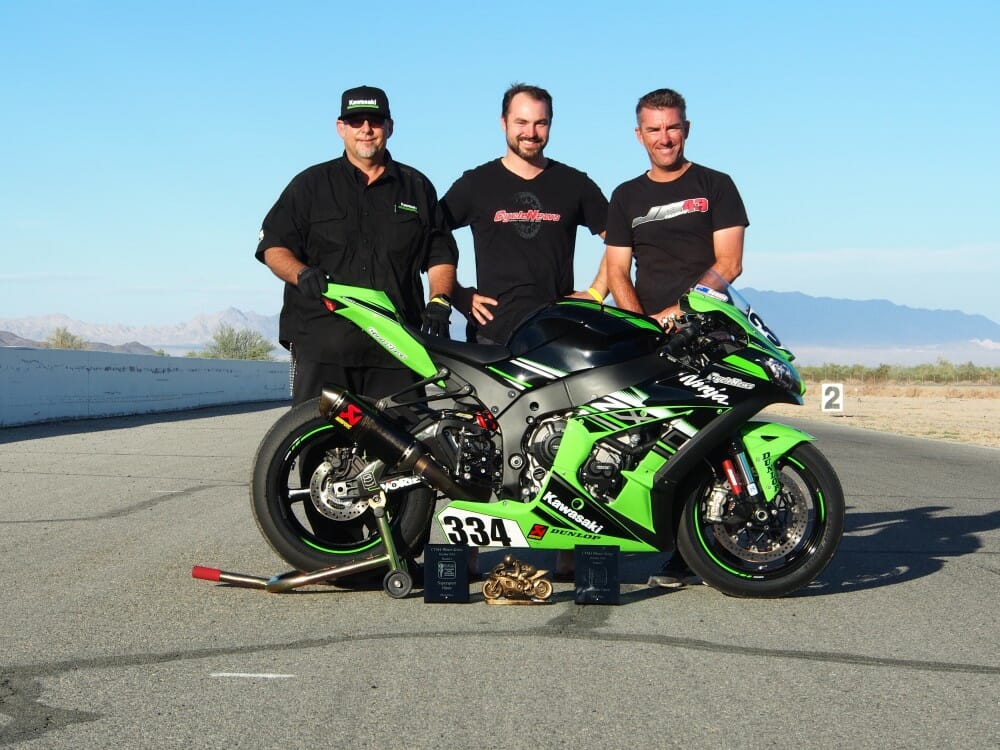 Kawasaki USA’s wrenchman Joey Lombado (left) was tasked with building this green weapon. Jason Pridmore (right) had the task of getting Rennie up to speed. Rennie (center) just had to not crash it!
Kawasaki USA’s wrenchman Joey Lombado (left) was tasked with building this green weapon. Jason Pridmore (right) had the task of getting Rennie up to speed. Rennie (center) just had to not crash it!
The Transformation
Taking a stock-standard bike and turning it into a racer is pretty easy these days. Modern superbikes, no matter what the brand, are all so fast that to make them competitive doesn’t require nearly half the mods of 10-15 years ago.
Of course, if you want to really build a racer that could be competitive in something like MotoAmerica’s Superbike class, you may want to delve a bit further into go-fast parts bin. But in this spec, according to test rider Jeremy Toye, this bike would be a competitive mount in the Superstock class, although the real purpose of the build is for it to be a club racer.
“For this bike, we wanted to showcase our race kit parts and how effective they are,” says Kawasaki USA’s Media Relations Supervisor, Brad Puetz. “We create a bike that a club racer could build on his own with our Kawasaki kit parts and a few aftermarket parts, and that racer can then go out and win our industry-leading contingency money! We also wanted to show the adjustability of the bike through mapping of kit ECU, chassis adjustments, engine braking, launch control, etc. Also, it was also a great way to show how the ZX-10R makes competitive power without having to spend thousands of dollars on building a superbike motor. The build could serve as a blueprint on how to build a competitive Kawasaki road race bike from parts available to every racer.”
The build was thus left to Joey Lombado, long-time Kawasaki employee and former mechanic to AMA legends like Eric Bostrom, Miguel Duhamel and Tommy Hayden. As Joey explains, there’s really not a lot required to take the standard street bike and make it competitive.
“It was basically a strip-and-fit project,” says Lombado. “We didn’t want to spend a ton of money on something unattainable, so we didn’t touch the cylinder head or even fit the race cams that you can get out of the Kawasaki catalog.”
We had some great partners in building this bike, and the end result was about 187 horsepower at the wheel. That kind of power from a near stock engine is super impressive, and also hints that there’s a lot more in there if we chose to build a full race motor.
“We spent a day working with Jeremy Toye at Laguna Seca earlier in the year to work out what traction and wheelie control maps we wanted, as well as the engine braking, launch control and auto blip for the downshift, as well as some geometry changes via the OEM swingarm pivot locations. That gave us a nice, neutral-handling machine.
“We also tested out some different clutch plates to work with the launch-control settings. I think we got the setting exactly right because when Rennie had that clutch he holeshoted twice, but when we had to go back to a standard clutch on the final race weekend, his starts weren’t nearly as good!”
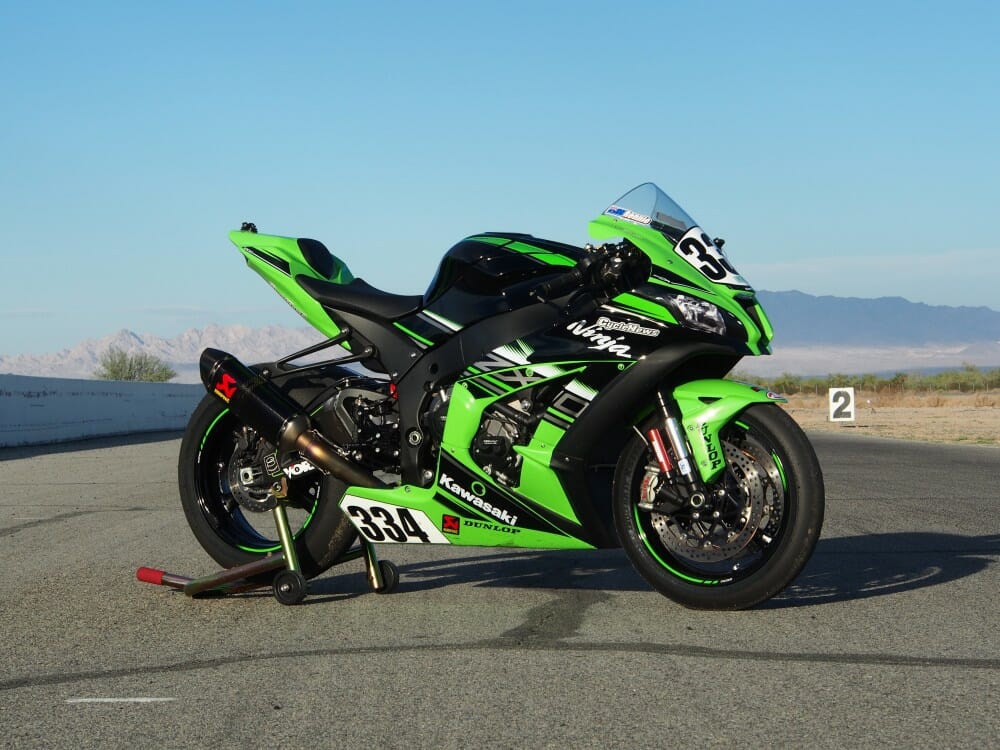 The Kawasaki USA ZX-10R Project racer in all its glory. Thank you to each and every company that played a part in this build.
The Kawasaki USA ZX-10R Project racer in all its glory. Thank you to each and every company that played a part in this build.
Here’s a list of the new parts fitted to make this bike a reality.
MC Pro Design’s Race Paint: PHONE (760) 738 0521 (Chad Jenson)
Joey Lombado Racing: KRT green drive chain, rear sprockets, hand-built rear-brake line

(Left) Akrapovic Racing Line Carbon/Titanium Exhaust
(Right) Dunlop N-Tec 200-section Soft Compound Rear Slick

(Left) Dunlop N-Tec 120-section Medium Compound Front Slick
(Right) Maxima Racing Oils RS010 Coolant
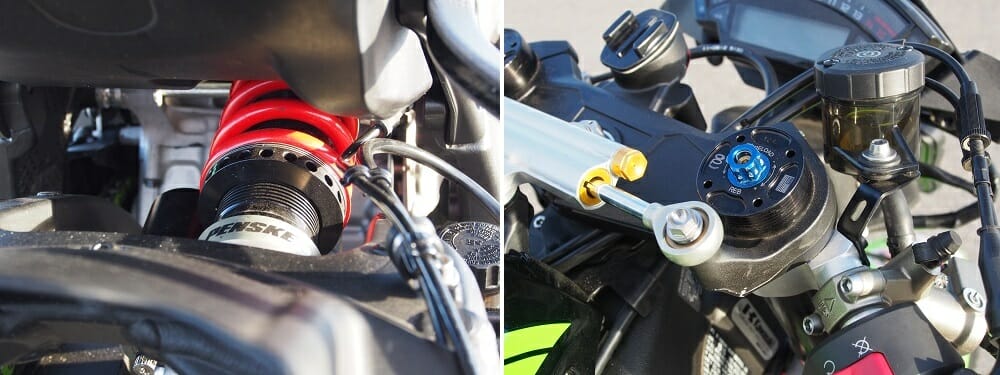
(Left) Penske Racing 8987 shock with variable bleed piston built by GP Suspension
(Right) GP Suspension 25mm Fork Cartridge Kit, separate rebound and compression damping circuits
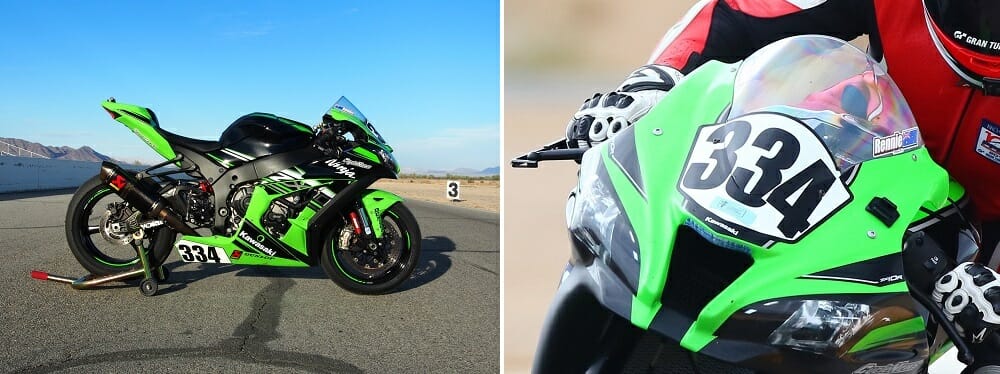
(Left) Catalyst Racing Composites Bodywork
(Right) Drippin Wet Race Decals and Numbers
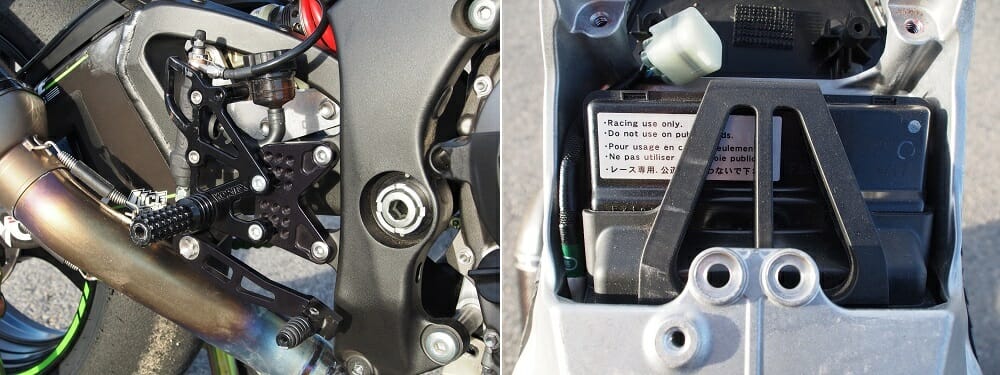
(Left) Vortex Rearsets and Front Drive Sprockets
Racers Edge Performance Front Brake Guard
Kawasaki Racing Kit ECU (Above Right) , Harness, oil catch tank, head pipe collar, ride height spacer set, chain guard.
To read the CN 2016 Kawasaki ZX-10R Rider Project: Part Two, click HERE
To read the CN 2016 Kawasaki ZX-10R Rider Project: Part Two, click HERE
To read the CN 2016 Kawasaki ZX-10R Rider Project: Part Three, click HERE
To read this in Cycle News Digital Edition, click HERE